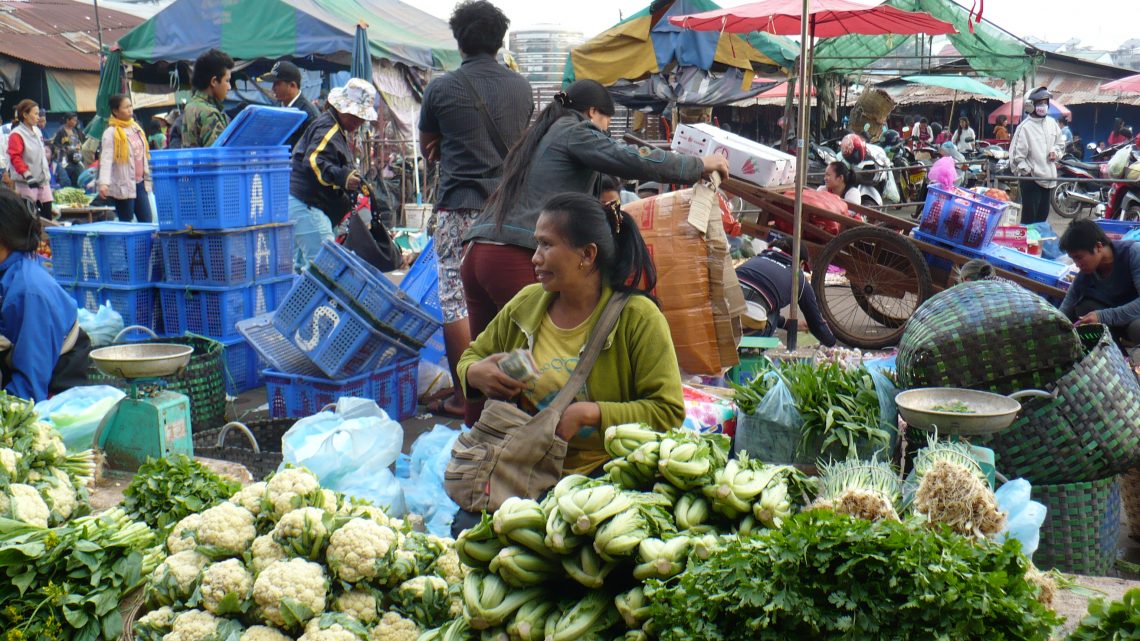Since our daughter, Kelti, is teaching at a school in Laos we decided to spend our holiday visiting her. It was an amazing experience for our family since we had never traveled to an Asian country before. This set of blogs describes our adventures and lessons from them I want to remember.
The Market
After over 40 hours of travel, we arrived in the capital city of Laos. Kelti met us at the station and engaged a tuk-tuk to transport us and our luggage to the guesthouse where we would stay.
The first morning we were in Vientiane we went to the local market. It starts at daybreak and the fresh food section closes about 8 am. So you have to get an early start. We decided to walk, mostly to get used to how the traffic works before we started riding bikes around. We took our day packs to carry the food back to the guesthouse and headed out.
The streets were already very busy, and walking for about 30 minutes and looking at everything was extremely interesting. But when we actually reached the market, sensory overload achieved a new dimension. The brilliant colors, the sounds, the sense of every packed inch of space being used was just amazing.
If I hadn’t been following Kelti, I would have gotten lost quickly, because you have to go through a covered maze of permanent vendor stalls to reach the center of the market where the fresh produce is sold. And we had to go through the meat market, which was quite a journey. I tried not to look or smell, just keep my eyes on the little trail in front of me and not walk through too much blood or bump into things. It helped me understand why you always remove your shoes when going inside!
The Food
Finally we emerged into the sunlight and saw fresh things being sold for food that grew from the Earth. Some items we could identify ~ like oranges and bananas, of the miniature variety, which we discovered were deliciously sweet! There were also carrots and cucumbers and apples and onions…and many types of green leaf vegetables I had never seen before. Lao people eat lots of fruits and vegetables.
We tried Dragon Fruit first. It has colorful shells that are peeled off to reveal white insides with black seeds like a kiwi. And we tried Tamarind, which doesn’t look exciting on the outside but is worth the effort of breaking open the brittle, brown shells, to suck the sweet, tangy brown fruit off the large seeds that are in each pod.
Some market vendors had their prices displayed; that was easier for us, although Kelti has learned enough language to navigate through most sections of the market. Later that day when we were buying clothing, if the vendor did not speak English, we would point to an item and she would punch the numbers into a calculator and show us the amount. That worked pretty well.
We also saw lots of rice in the market. When we went into the countryside a few days later we saw a few rice paddies in operation, but only the ones that were being irrigated since it is the dry season. When the rains come, starting in April, then rice cultivation becomes a major agricultural enterprise for all ages of people.
One interesting thing we learned is that men who have a job other than working in the fields (or some other type of manual labor) will grow their fingernails long, especially the pinky nail. It is a symbol of their status above day laborers. We started noticing that all the male restaurant workers and taxi and tuk-tuk drivers had at least one long fingernail, sometimes all of them except for their thumbs.
The Money
The local currency is the Kip, which exchanges currently at the rate of 8,000 per US dollar. So after we went to the bank and cashed some traveler’s cheques, my husband Gary happily told me that I was married to a millionaire! (About US$125 qualifies one for that status.) There is no use of coins in Laos. Their smallest bill is 500 Kip, which is equivalent to about a nickel.
There seem to be several economic classes in Laos between the very poor, who we saw living in bamboo huts in the mountains, and the very rich, who are driving expensive cars and living in huge cement houses. Termites are a big problem, so everyone who can afford to builds a concrete home with only wooden doors and window frames. We saw many beautiful new homes being built on the outskirts of Vientiane. Most people cook and eat outside, and there are no screens on the windows or glass panes. Many have wooden shutters, which I suppose they close during the rains.
We saw several large, white buildings in the city with terra cotta tiled roofs. They are mostly government buildings. Since 1975 the government has been Communist, but it is called a democratic republic because elections are held—people can vote for the communist candidate if they want to. We saw government police officers in tan uniforms regularly around the city.
It was very interesting to observe the culture, their ways of functioning, and their value systems. When I asked Kelti what makes Lao people happy she said, “making money and their family honor system.” Money is very important to them and they want to make as much as possible.
Lesson #1
As I think about different life philosophies, I hope that my attitude about money and its use reflects my Christian perspective that every material thing is a gift from God, that He knows my needs and desires, that it all belongs to Him and we should never, ever judge or value people based on how much or little money they happen to possess.










